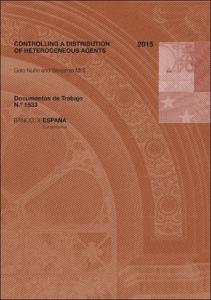Controlling a distribution of heterogeneous agents
Autor
Fecha de publicación
20-nov-2015
Descripción física
42 p. : gráficos, fórmulas
Resumen
Este artículo analiza el problema de un planificador benevolente que desea controlar una población de agentes heterogéneos sujetos a perturbaciones idiosincrásticas. Esto es equivalente a un problema de control determinista en el que la variable de estado pertinente es la distribución de agentes. Demostramos cómo, trabajando en tiempo continuo, este problema puede descomponerse en una ecuación de programación dinámica junto a la ley de movimiento de la distribución y presentamos un nuevo algoritmo para resolverlo numéricamente. Como aplicación, analizamos la solución eficiente-restringida de una economía à la Aiyagari con una distribución de la riqueza que replica la observada en los datos. Nuestros resultados indican que la solución óptima se caracteriza por un nivel de desigualdad de la riqueza mayor que el observado en el equilibrio competitivo
This paper analyzes the problem of a benevolent planner wishing to control a population of heterogeneous agents subject to idiosyncratic shocks. This is equivalent to a deterministic control problem in which the state variable is the cross-sectional distribution. We show how, in continuous time, this problem can be broken down into a dynamic programming equation plus the law of motion of the distribution, and we introduce a new numerical algorithm to solve it. As an application, we analyze the constrained-efficient allocation of an Aiyagari economy with a fat-tailed wealth distribution. We find that the constrained-efficient allocation features more wealth inequality than the competitive equilibrium
This paper analyzes the problem of a benevolent planner wishing to control a population of heterogeneous agents subject to idiosyncratic shocks. This is equivalent to a deterministic control problem in which the state variable is the cross-sectional distribution. We show how, in continuous time, this problem can be broken down into a dynamic programming equation plus the law of motion of the distribution, and we introduce a new numerical algorithm to solve it. As an application, we analyze the constrained-efficient allocation of an Aiyagari economy with a fat-tailed wealth distribution. We find that the constrained-efficient allocation features more wealth inequality than the competitive equilibrium
Publicado en
Documentos de Trabajo / Banco de España, 1533
Materias
Ecuación de Kolmogorov; Distribución de la riqueza; Función de bienestar social; Control óptimo; Kolmogorov forward equation; Wealth distribution; Social welfare function; Mean field control; Métodos matemáticos y de programación; Factores de producción y distribución; Renta, empleo y precios
Aparece en las colecciones:












